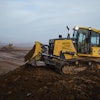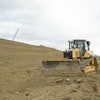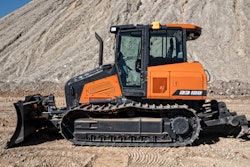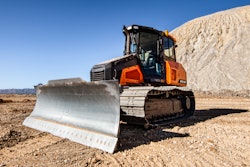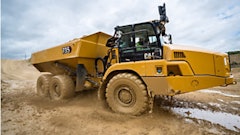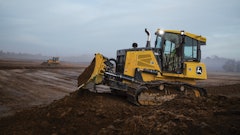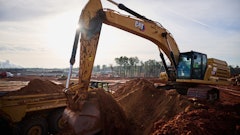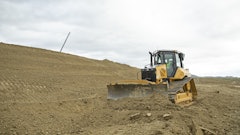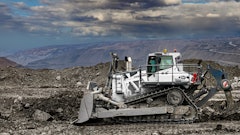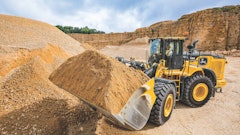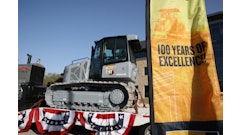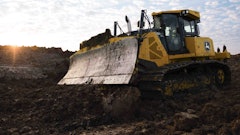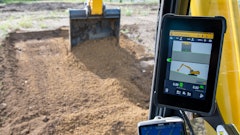Check out the video, right here:
Mid-way through last year Cat re-launched, or rethought, one of its most popular dozers. And it’s a model so important that just more than one year later, they’ve already updated it again.
We’re talking about the new Cat D4. Aka, the dozer formerly known as the Cat D6K2.
This medium size-class dozer weighs in at 29,259 pounds and is powered by a Cat C4.4 engine producing 130 horsepower, mated to a hydrostatic transmission.
Over the years, the D6K2 had established a lasting legacy built upon its grading prowess and a strong resale market presence. Really, the biggest problem with that machine, in Cat’s eyes, was the name. But not just the name of the D6K2. In 2017 Cat began to roll out a new method for naming all of its new machine models. The nomenclature change came about after years of hearing from costumers that the model names had gotten too complicated.
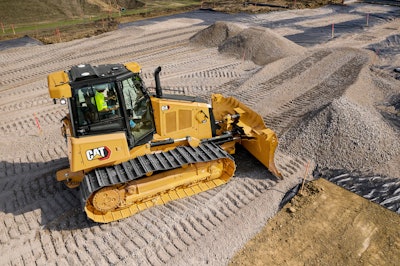
The D6K2 was part of a model family that exemplified this perfectly. At one point in time, if you were in the market for a D6 dozer, you could choose between a D6K2, a D6N, or a D6T. The confusing part of this each of those machines were extremely different—but all were being referred to as customers as simply a D6.
So, as much as possible, Cat has been trying to get rid of those letter modifiers—like K, N, and T—and is instead hoping to communicate size class through numbers.
As these model names in the rethought Cat dozer lineup bear out, the dozer range is now being named from smallest to largest with almost no more letter modifiers. New models include the D1, D2, and D3, while the D5 replaced what was the D6N; the D6 and D6 XE (the XE is the outlier in this new future of no letter modifiers because Cat needed some way to denote a premium model) replaced the D6; and the D7 replaced the D7E and D7R.
What’s proven and what’s new
So, yes. The much-loved model at the heart of this discussion has a new name and there are lots of folks with varying opinions and feelings about this change, especially as it pertains to resale. But the D4 is here, so what else is new apart from the name?
If we were having this discussion last year, the answer would have been not much. That initial D4 was basically a D6K2 with the new Cat logo and the new D4 model name slapped on it.
But for 2021, Cat has implemented some meaningful changes to this new, new D4. There’s a new exterior design to talk about, reductions in operating cost and cab improvements.
But let’s start with what has been carried over from the D6K2.
The D4 still has the same roller frame, tractor frame, C-frame, Cat C4.4 engine and horsepower that were found on the D6K2. The D6K2’s proven undercarriage design is still there too.
With eight bottom rollers and two carrier rollers, this setup still provides a smooth ride and great grading performance. Worth noting, the D4 is the only model of the new mid-size dozers that hasn’t gone to a high-drive undercarriage design.
Three undercarriage configurations are available on the new D4 including the new Cat Abrasion undercarriage with double the seal life and complete elimination of bushing turns. Cat says this undercarriage reduces operating costs up to 50 percent per hour compared to a traditional undercarriage.
Another option is the High Abrasion undercarriage which implements larger links, bushings and pins for even longer life aimed at work in the type of sand you find along the Gulf Coast.
Finally there’s Heavy Duty Extra Life, or HD XL, which uses thicker bushings, a thicker rail and a rail to pin interaction design that does a better job of keeping oil in the joints.
The D4 is available in a low ground pressure configuration and a variable pitch angle tilt blade is standard. A foldable VPAT blade is an available option.
More visibility, more comfort
If you’ve been staring at the nose of this machine, you’ve already identified the first big difference between it and the 2020 D4 and the old D6K2.
Cat has dropped the slope of the hood to improve visibility and shorten sight lines between the blade and what you’re pushing. Cat says the dropped nose has improved overall visibility by 30 percent, while shortening the sight lines to the material by 40 percent. The result should be less time spent backing up to get a better view of the material.
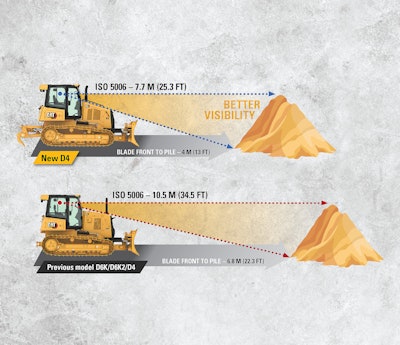

The 2021 D4 also gets Cat’s latest next-generation dozer cab found on the larger D5 through D7 models. Inside, there’s a new, more comfortable seat with improved suspension. The seat has 13 adjustment points and the armrests can be adjusted as well.
Cat says they’ve improved airflow and pressurization in this new cab design and they’ve also implemented a standard 10-inch touchscreen display for system navigation and rear view camera display.
That 10-inch display is also your portal into several technology features that Cat includes standard on the D4.
Those are:
- Cat Link Telematics Application profiles and operator IDs for quick recall of preferred machine settings
- Slope Indicate, which shows machine main fall and cross-slope on the display
- Stable blade
- Traction control
- Cat Grade with Slope Assist, which gives you basic blade positioning assistance without GPS.
If you want to go with full 3D machine control, you can add Cat Grade with 3D from the factory.
Maintenance improvements
Earlier I mentioned how the undercarriages available for the D4 can save you money. But Cat has also made some changes on the maintenance side of this machine to push operating costs even lower.
For starters there’s a new air filter that is larger, easier to clean and lasts twice as long as the previous filter, going 1,000 hours between needed service.
In fact, Cat has extended the service intervals of all its base serviceable components including the engine oil, engine oil filter to 1,000 hours.
The result is a 7% reduction in maintenance costs.


